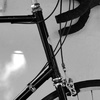Use 70s Dia-Compe centerpulls with braze-on posts: need new bushings?
#1
Senior Member
Thread Starter
Join Date: Oct 2005
Location: Fresno, CA
Posts: 4,454
Mentioned: 6 Post(s)
Tagged: 0 Thread(s)
Quoted: 128 Post(s)
Likes: 0
Liked 12 Times
in
10 Posts
Use 70s Dia-Compe centerpulls with braze-on posts: need new bushings?
I'm getting my 1981 Nishiki frame modified by Erik Billings (CB Cycles in Oakland), including frame-mounted posts for centerpull brakes. Planning to go with Dia-Compe, because
(a) I have a bunch sitting around, in medium and long reach. 610 and 750, as least as they're called now
(b) the medium- and long-reach brakes share the same mounting width, and if I want to switch from 700c to 650b, I can just switch to longer brake arms. The rim diameter is 19mm difference (622/2 - 584/2) and the 14mm brake arm difference plus pad slots can cover that easily.
I know that Dia-Compe centerpulls need an alternate spring when using frame-mounted posts.
But do they also use different bushings? On the normal (plate-mounted) brakes, the red plastic press-fit pieces hold the brass bushing in the brake arm, and the bushings rotate around the fixing bolt (that holds the brake arm to the back plate). The frame-mounted posts are larger-diameter, and I think would replace the bushing, and perhaps the plastic.
Pictured: bushing assembly in brake arm and exploded, and front & back view of the medium- and long-reach brakes.
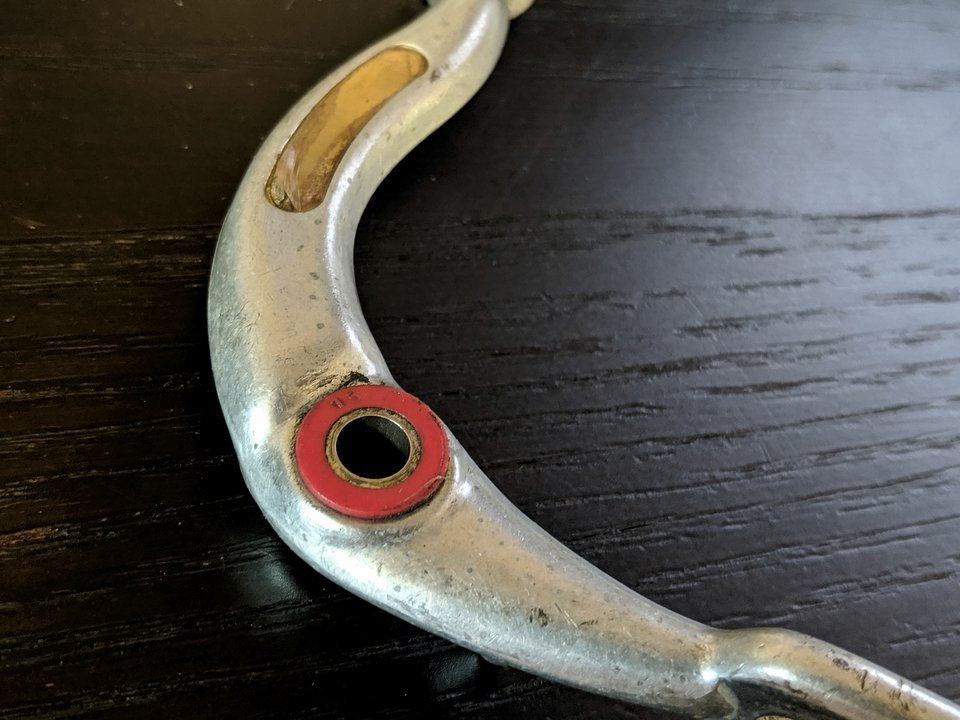
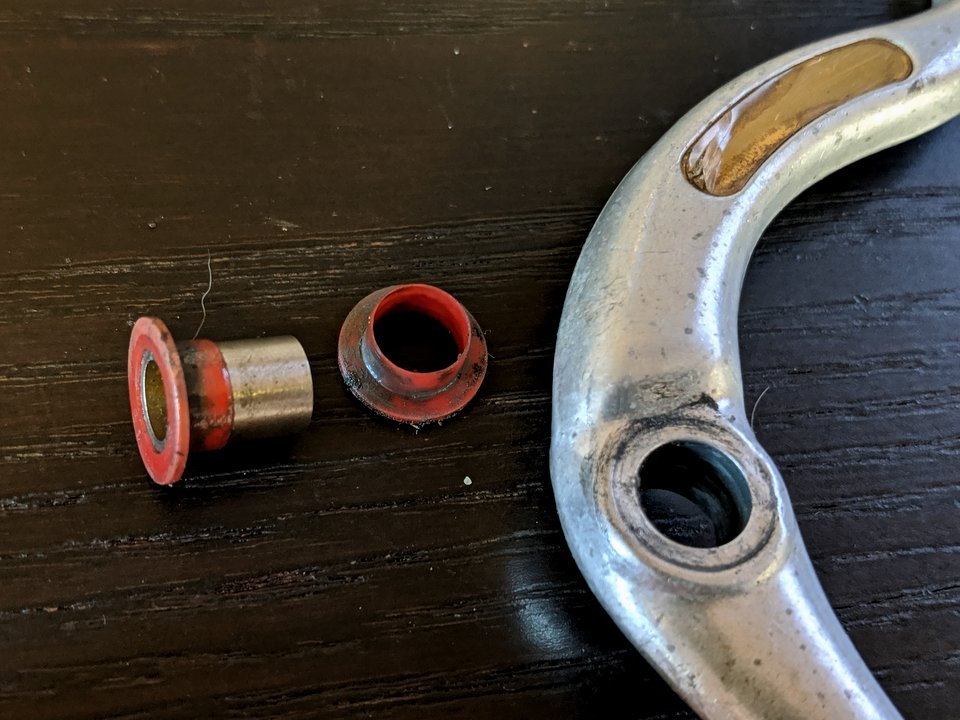
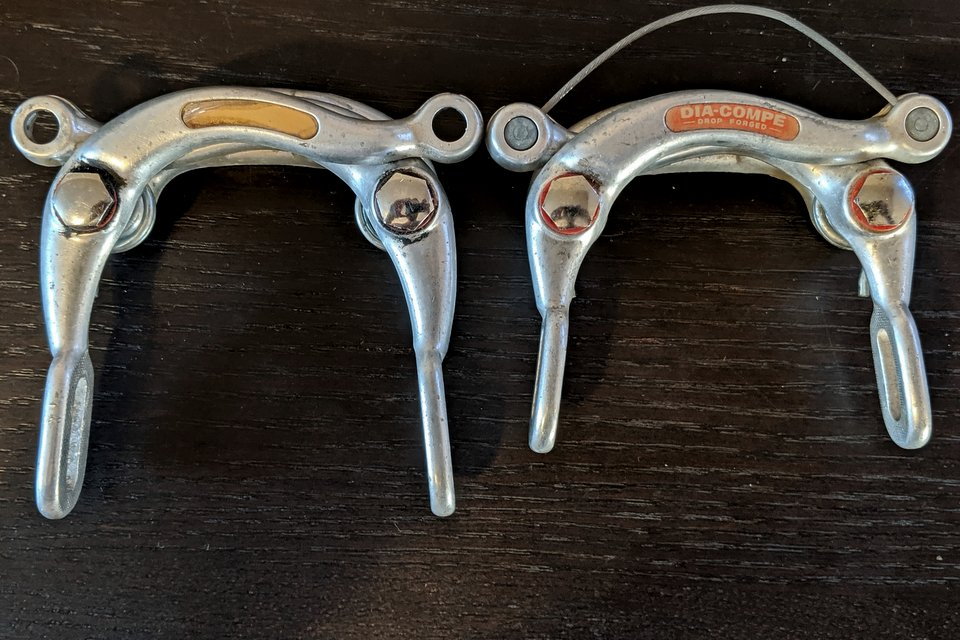
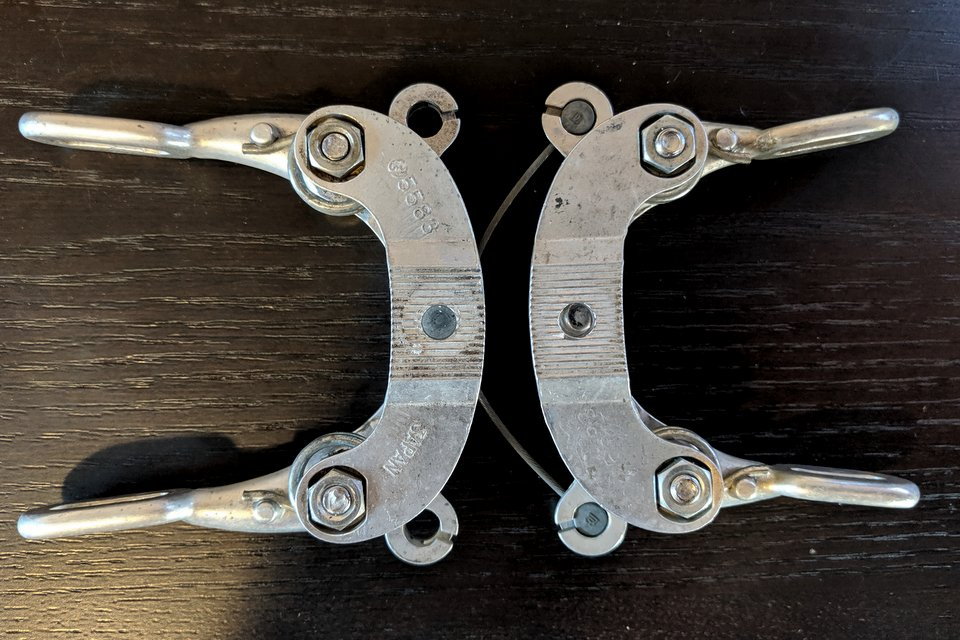
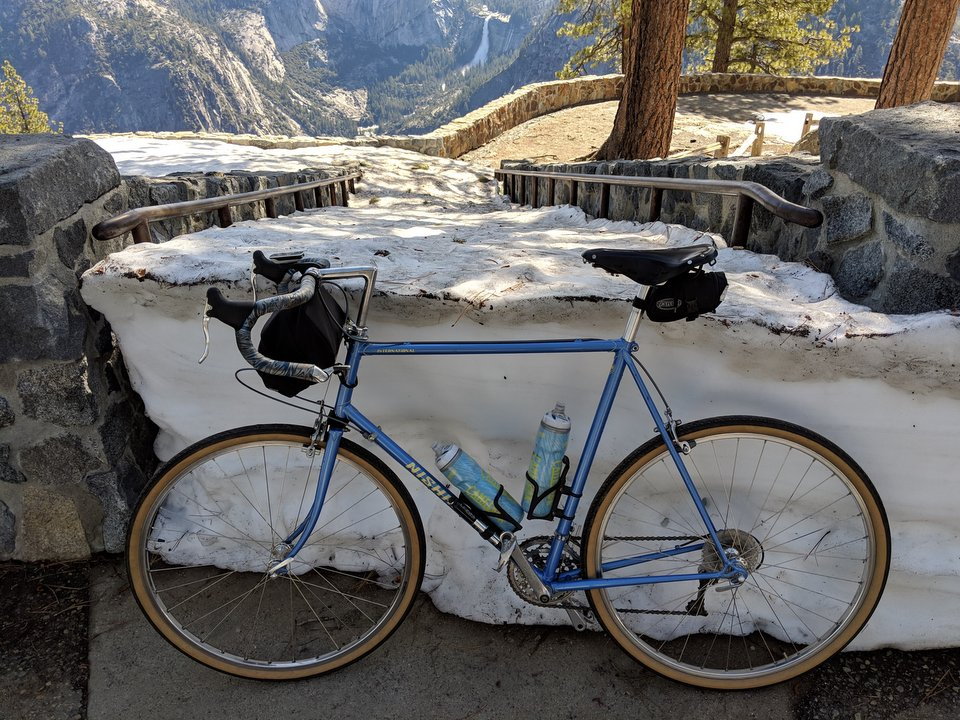
(a) I have a bunch sitting around, in medium and long reach. 610 and 750, as least as they're called now
(b) the medium- and long-reach brakes share the same mounting width, and if I want to switch from 700c to 650b, I can just switch to longer brake arms. The rim diameter is 19mm difference (622/2 - 584/2) and the 14mm brake arm difference plus pad slots can cover that easily.
I know that Dia-Compe centerpulls need an alternate spring when using frame-mounted posts.
But do they also use different bushings? On the normal (plate-mounted) brakes, the red plastic press-fit pieces hold the brass bushing in the brake arm, and the bushings rotate around the fixing bolt (that holds the brake arm to the back plate). The frame-mounted posts are larger-diameter, and I think would replace the bushing, and perhaps the plastic.
Pictured: bushing assembly in brake arm and exploded, and front & back view of the medium- and long-reach brakes.





#2
Senior Member
Join Date: Sep 2015
Location: Madison, WI
Posts: 2,701
Mentioned: 52 Post(s)
Tagged: 0 Thread(s)
Quoted: 1136 Post(s)
Liked 650 Times
in
336 Posts
I have seen a kit online for doing the conversion from center mount to braze-on mount. It includes new springs and spring-stops.
Found it - https://www.cyclestoussaint.com/prod...n-assembly-kit
According to the above page, braze-on posts for centerpull are smaller in diameter than normal canti posts. So perhaps you won't need to replace your bushings, unless your framebuilder is going to use canti posts.
Found it - https://www.cyclestoussaint.com/prod...n-assembly-kit
According to the above page, braze-on posts for centerpull are smaller in diameter than normal canti posts. So perhaps you won't need to replace your bushings, unless your framebuilder is going to use canti posts.
#3
Senior Member
Join Date: Nov 2013
Location: Big Apple
Posts: 1,428
Bikes: yes
Mentioned: 17 Post(s)
Tagged: 0 Thread(s)
Quoted: 512 Post(s)
Likes: 0
Liked 409 Times
in
176 Posts
But do they also use different bushings? On the normal (plate-mounted) brakes, the red plastic press-fit pieces hold the brass bushing in the brake arm, and the bushings rotate around the fixing bolt (that holds the brake arm to the back plate). The frame-mounted posts are larger-diameter, and I think would replace the bushing, and perhaps the plastic.
Pictured: bushing assembly in brake arm and exploded, and front & back view of the medium- and long-reach brakes.

Pictured: bushing assembly in brake arm and exploded, and front & back view of the medium- and long-reach brakes.

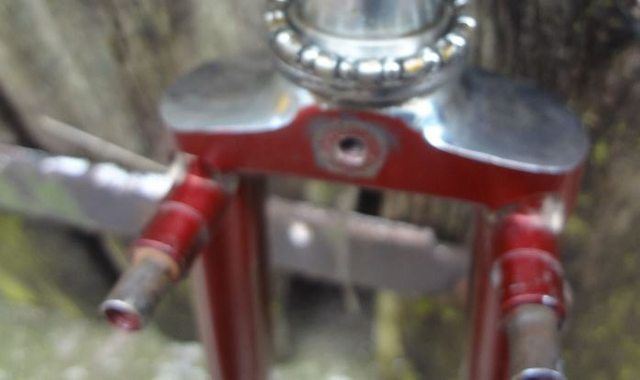
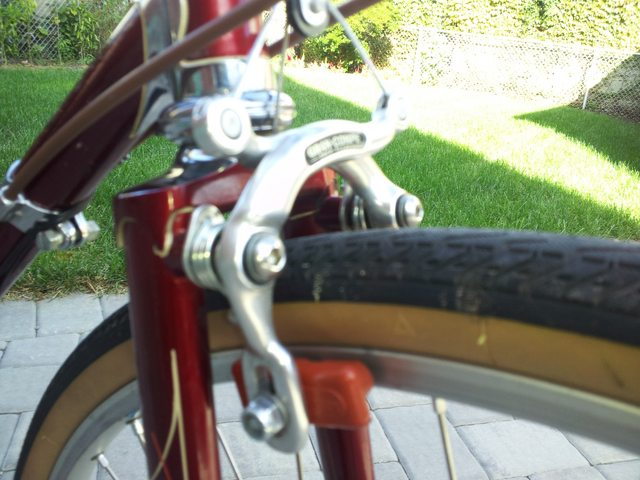

#4
Senior Member
Thread Starter
Join Date: Oct 2005
Location: Fresno, CA
Posts: 4,454
Mentioned: 6 Post(s)
Tagged: 0 Thread(s)
Quoted: 128 Post(s)
Likes: 0
Liked 12 Times
in
10 Posts
I have seen a kit online for doing the conversion from center mount to braze-on mount. It includes new springs and spring-stops.
Found it - https://www.cyclestoussaint.com/prod...n-assembly-kit
According to the above page, braze-on posts for centerpull are smaller in diameter than normal canti posts. So perhaps you won't need to replace your bushings, unless your framebuilder is going to use canti posts.
Found it - https://www.cyclestoussaint.com/prod...n-assembly-kit
According to the above page, braze-on posts for centerpull are smaller in diameter than normal canti posts. So perhaps you won't need to replace your bushings, unless your framebuilder is going to use canti posts.
I could have phrased my original question better, but what I'm wondering is which pieces of the current bushing assembly (the red plastic bits and the brass bushing that press-fits between them) would I use to mount these Dia-Compe brakes onto frame-mounted centerpull posts? The reason I ask is that the brass bushing is too narrow to mount on posts - only the bolt (that connects the brake arms to the backing plate) fits between them in the typical assembly on a frame without brazed-on posts.
#5
Senior Member
Thread Starter
Join Date: Oct 2005
Location: Fresno, CA
Posts: 4,454
Mentioned: 6 Post(s)
Tagged: 0 Thread(s)
Quoted: 128 Post(s)
Likes: 0
Liked 12 Times
in
10 Posts
I've got a 1979 Centurion Pro Tour with braze on centerpulls, that I built up from a frame. I first used a pair of Weinman centerpulls, then switched to an old set of Dia Compe Gran Compe centerpulls. Both worked fine. You do, however, need to obtain the springs and plates. I got mine from the link TenGrainBread posted. I've seen them occasionally on eBay for about the same price (I did try emailing Dia Compe direct, but got no reply). The barrel bushing in bolt-on brakes isn't used in this application; the braze-on post takes the place of it. You do reuse the plastic press-fit pieces. I replaced the original brake caliper bolts with allen head bolts (I can't remember if I needed to get longer ones).
I have a follow-up question: in all Dia-Compe centerpull brakes that I've disassembled, the brass bushing is press-fit into the plastic pieces which fit into the brake arm; the actual rotation happens between the brass bushing and the bolt. I'd guess that the braze-on post is slightly smaller diameter than the brass bushing, so that it doesn't press-fit into the plastic pieces (which fit tight enough to inhibit brake rotation).
The framebuilder who is modifying my frame will source the springs and plates. I know that Compass/Rene Herse also stocks them; they got Dia-Compe to do a production run for them (Dia-Compe and Mafac apparently use the same posts).
#7
Senior Member
Join Date: Apr 2012
Location: Middle Earth (aka IA)
Posts: 20,435
Bikes: A bunch of old bikes and a few new ones
Mentioned: 178 Post(s)
Tagged: 0 Thread(s)
Quoted: 5888 Post(s)
Liked 3,472 Times
in
2,079 Posts
Looking forward to seeing the build. I'm curious but why go with frame mounted centerpulls rather than cantilevers since you are modding your frame and have a choice? Are they that much better? It's certainly a cool looking design.
#8
aged to perfection
Join Date: Jun 2009
Location: PacNW
Posts: 1,820
Bikes: Dinucci Allez 2.0, Richard Sachs, Alex Singer, Serotta, Masi GC, Raleigh Pro Mk.1, Hetchins, etc
Mentioned: 24 Post(s)
Tagged: 0 Thread(s)
Quoted: 840 Post(s)
Liked 1,262 Times
in
667 Posts
it may be that the Compass bushings will fit. I'll bet the ID is the same but the OD (the part that presses into the arm) might need some custom machining ha ha. Meaning, chuck the bushing in your drill press between two nuts and washers and fit the diameter to the size of the bore in the arm.
This is a cool project. I've done it before. Contact me off list if you need help
Mark Petry
Bainbridge Island, WA USA
This is a cool project. I've done it before. Contact me off list if you need help
Mark Petry
Bainbridge Island, WA USA
#9
framebuilder
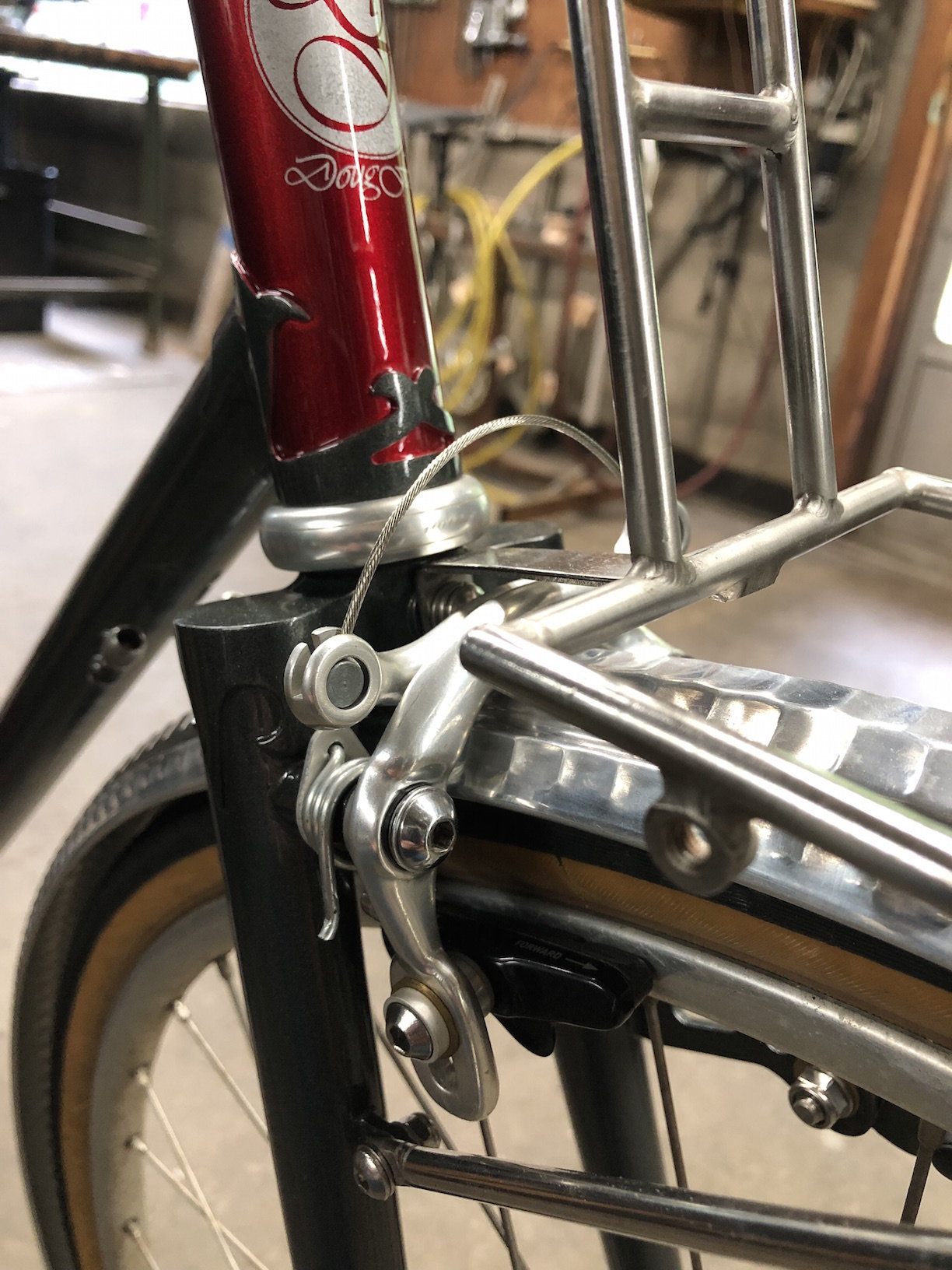
Here is a picture of center pull brake braze-ons I just put on an old frame I made back in 1977. I redid the frame entirely with all new braze-ons and new paint. The posts themselves I got from Dia Compe many many years ago. If you look closely you can see that the posts came with an aluminum tear shaped spring holder. It was kept from moving on the post by a flat spot that fit over a flat spot on the braze-on post. The plastic bushings were the same on the yoke (that I removed) when I used the braze-on posts.
The reason I like center pull brakes better than cantilevers is because the arms don't stick out as far (where they are most likely to catch something) and in my opinion look nicer.
#10
Bike Butcher of Portland
Join Date: Jul 2014
Location: Portland, OR
Posts: 11,639
Bikes: It's complicated.
Mentioned: 1299 Post(s)
Tagged: 0 Thread(s)
Quoted: 4682 Post(s)
Liked 5,803 Times
in
2,286 Posts
Answering for myself, I prefer the brazed on centerpulls over cantilevers because I can get stopping power and modulation. With cantilevers it seems I have to choose one or the other, with straddle cable length being the "knob" to adjust.
__________________
If someone tells you that you have enough bicycles and you don't need any more, stop talking to them. You don't need that kind of negativity in your life.
If someone tells you that you have enough bicycles and you don't need any more, stop talking to them. You don't need that kind of negativity in your life.
#11
Senior Member
Thread Starter
Join Date: Oct 2005
Location: Fresno, CA
Posts: 4,454
Mentioned: 6 Post(s)
Tagged: 0 Thread(s)
Quoted: 128 Post(s)
Likes: 0
Liked 12 Times
in
10 Posts
Thanks for the feedback, everyone. I will post pictures of the final result.
Some people asked why I'm going with centerpull brakes instead of cantilevers. Both work well with larger tires and fenders (up to a point). The main reason is that frame-mounted centerpull brakes have their bosses closer to the frame brace (either fork crown or rear brake bridge) and thus the posts rotate less under hard braking, meaning less need for toe-in.
Thanks for the info and the offer. I looked up the Compass/Herse bushings - they say they're designed for Mafac, and I suspect there's very little room for a bushing between the Dia-Compe brake arm hole and the post, since it's only supposed to fit those thin plastic washers. But I'll measure the OD when I get home.
Doug, I notice that your rando rack just has a standard horizontal steel piece that connects to the center hole of the fork crown. I always figured this would interfere with the centerpull brake arms. Was it tricky for you to get that piece not interfereing with the brake arms? The alternative is front racks that whose secondary mounting point is on the brake bosses.
One other question: I have some Mafac Racers (the medium-reach centerpull brake, comparable to the Dia-Compe 610s). I could have the framebuilder position the posts for Mafac brakes instead of Dia-Compe. Do people here have a preference on which type of centerpull brake?
I've heard some statements that Mafacs have better performance. The thing I like about Dia-Compe centerpulls (beyond the fact that I have a bunch of them) is that I could swap out the medium-reach 610s for long-reach 750s if I ever want to switch to 650b wheels.
Some people asked why I'm going with centerpull brakes instead of cantilevers. Both work well with larger tires and fenders (up to a point). The main reason is that frame-mounted centerpull brakes have their bosses closer to the frame brace (either fork crown or rear brake bridge) and thus the posts rotate less under hard braking, meaning less need for toe-in.
it may be that the Compass bushings will fit. I'll bet the ID is the same but the OD (the part that presses into the arm) might need some custom machining ha ha. Meaning, chuck the bushing in your drill press between two nuts and washers and fit the diameter to the size of the bore in the arm.
This is a cool project. I've done it before. Contact me off list if you need help
This is a cool project. I've done it before. Contact me off list if you need help
Here is a picture of center pull brake braze-ons I just put on an old frame I made back in 1977. I redid the frame entirely with all new braze-ons and new paint. The posts themselves I got from Dia Compe many many years ago. If you look closely you can see that the posts came with an aluminum tear shaped spring holder. It was kept from moving on the post by a flat spot that fit over a flat spot on the braze-on post. The plastic bushings were the same on the yoke (that I removed) when I used the braze-on posts.
One other question: I have some Mafac Racers (the medium-reach centerpull brake, comparable to the Dia-Compe 610s). I could have the framebuilder position the posts for Mafac brakes instead of Dia-Compe. Do people here have a preference on which type of centerpull brake?
I've heard some statements that Mafacs have better performance. The thing I like about Dia-Compe centerpulls (beyond the fact that I have a bunch of them) is that I could swap out the medium-reach 610s for long-reach 750s if I ever want to switch to 650b wheels.
#12
Senior Member
Thread Starter
Join Date: Oct 2005
Location: Fresno, CA
Posts: 4,454
Mentioned: 6 Post(s)
Tagged: 0 Thread(s)
Quoted: 128 Post(s)
Likes: 0
Liked 12 Times
in
10 Posts
One other question: I have some Mafac Racers (the medium-reach centerpull brake, comparable to the Dia-Compe 610s). I could have the framebuilder position the posts for Mafac brakes instead of Dia-Compe. Do people here have a preference on which type of centerpull brake?
I've heard some statements that Mafacs have better performance. The thing I like about Dia-Compe centerpulls (beyond the fact that I have a bunch of them) is that I could swap out the medium-reach 610s for long-reach 750s if I ever want to switch to 650b wheels.
I've heard some statements that Mafacs have better performance. The thing I like about Dia-Compe centerpulls (beyond the fact that I have a bunch of them) is that I could swap out the medium-reach 610s for long-reach 750s if I ever want to switch to 650b wheels.
So I plan to stick with brazed-on posts for Dia-Compe because if I stick with 700c wheels the Dia-Compe 610s are fairly comparable in power to Mafac Racers, but also give me the ability to switch to 650b wheels (somewhat weaker braking with the longer-armed 750s).
#13
Senior Member
Join Date: Nov 2013
Location: Big Apple
Posts: 1,428
Bikes: yes
Mentioned: 17 Post(s)
Tagged: 0 Thread(s)
Quoted: 512 Post(s)
Likes: 0
Liked 409 Times
in
176 Posts
Great, the bolded info is I was looking for.
I have a follow-up question: in all Dia-Compe centerpull brakes that I've disassembled, the brass bushing is press-fit into the plastic pieces which fit into the brake arm; the actual rotation happens between the brass bushing and the bolt. I'd guess that the braze-on post is slightly smaller diameter than the brass bushing, so that it doesn't press-fit into the plastic pieces (which fit tight enough to inhibit brake rotation).
The framebuilder who is modifying my frame will source the springs and plates. I know that Compass/Rene Herse also stocks them; they got Dia-Compe to do a production run for them (Dia-Compe and Mafac apparently use the same posts).
I have a follow-up question: in all Dia-Compe centerpull brakes that I've disassembled, the brass bushing is press-fit into the plastic pieces which fit into the brake arm; the actual rotation happens between the brass bushing and the bolt. I'd guess that the braze-on post is slightly smaller diameter than the brass bushing, so that it doesn't press-fit into the plastic pieces (which fit tight enough to inhibit brake rotation).
The framebuilder who is modifying my frame will source the springs and plates. I know that Compass/Rene Herse also stocks them; they got Dia-Compe to do a production run for them (Dia-Compe and Mafac apparently use the same posts).
I'm not sure what you're getting out regarding the bushing, but the arms pivot on the "metal bushing" / "Delrin bushing" (Dia Compe terms for the parts) combination. The bolt just holds everything in place. The Delrin plastic is sandwiched between the metal bushing, or the post, and the caliper arm hole.
On my frame, the Delrin bushings were tight to put on the post, so I sanded it down with some sand paper and they slipped right on. I also sanded the inside the caliper arm holes, because they weren't particularly smooth, now they are. Everything got a thin coating of grease. Works great, without binding.
#14
Senior Member
One other question: I have some Mafac Racers (the medium-reach centerpull brake, comparable to the Dia-Compe 610s). I could have the framebuilder position the posts for Mafac brakes instead of Dia-Compe. Do people here have a preference on which type of centerpull brake?
I've heard some statements that Mafacs have better performance.
I've heard some statements that Mafacs have better performance.
Mafac feel like the have a little more brute stopping force. Not sure if they do or not, but it feels like it. The are in fact a little brutish and not subtle. The stop good.

610s/Weinmans feel slightly more refined and modulate a little better IMO. Stopping power is still very good, but they are a step towards Campy record brakes in subjective feel. A little more controlled.
In stock form, 610s are more rigid. Mafac Racer caliper arms bend visibly when you squeeze the brake lever. That probably acounts for the feel difference. Obviously if you are going with direct mount, this difference will be much less, as the Mafac flex will be much reduced.
I suspect that Mafac have more mechanical advantage. They feel like it. Straddle wires are easily adjusted to suit. While it is possible to put a shorter than stock straddle wire on a Dia Compe 610, it isn't easy, and if you do they start to feel weird and non linear.
It's kind of apples and oranges. Or maybe apples and pears. Really I like both.
I do prefer Mafac levers, mostly because they fit my hands better.
#15
Senior Member
Thread Starter
Join Date: Oct 2005
Location: Fresno, CA
Posts: 4,454
Mentioned: 6 Post(s)
Tagged: 0 Thread(s)
Quoted: 128 Post(s)
Likes: 0
Liked 12 Times
in
10 Posts
Re: Dia-Compe vs Mafac, I believe the springs are different, so make sure the correct ones are sourced. My understanding is that the original Mafac bolt-on brake springs work with braze-on plates, because of the way the Mafac brakes are designed.
I'm not sure what you're getting out regarding the bushing, but the arms pivot on the "metal bushing" / "Delrin bushing" (Dia Compe terms for the parts) combination. The bolt just holds everything in place. The Delrin plastic is sandwiched between the metal bushing, or the post, and the caliper arm hole.
On my frame, the Delrin bushings were tight to put on the post, so I sanded it down with some sand paper and they slipped right on. I also sanded the inside the caliper arm holes, because they weren't particularly smooth, now they are. Everything got a thin coating of grease. Works great, without binding.
I'm not sure what you're getting out regarding the bushing, but the arms pivot on the "metal bushing" / "Delrin bushing" (Dia Compe terms for the parts) combination. The bolt just holds everything in place. The Delrin plastic is sandwiched between the metal bushing, or the post, and the caliper arm hole.
On my frame, the Delrin bushings were tight to put on the post, so I sanded it down with some sand paper and they slipped right on. I also sanded the inside the caliper arm holes, because they weren't particularly smooth, now they are. Everything got a thin coating of grease. Works great, without binding.
The framebuilder who is doing my modifications was first to mention taht I'd need different springs; he is sourcing them for me.
I used to prefer Mafac Racers. Nowadays I find I have a slight preference for Weinmann/Gran/Dia-Compe.
Mafac feel like the have a little more brute stopping force. Not sure if they do or not, but it feels like it. The are in fact a little brutish and not subtle. The stop good.
610s/Weinmans feel slightly more refined and modulate a little better IMO. Stopping power is still very good, but they are a step towards Campy record brakes in subjective feel. A little more controlled.
In stock form, 610s are more rigid. Mafac Racer caliper arms bend visibly when you squeeze the brake lever. That probably acounts for the feel difference. Obviously if you are going with direct mount, this difference will be much less, as the Mafac flex will be much reduced.
I suspect that Mafac have more mechanical advantage. They feel like it. Straddle wires are easily adjusted to suit. While it is possible to put a shorter than stock straddle wire on a Dia Compe 610, it isn't easy, and if you do they start to feel weird and non linear.
It's kind of apples and oranges. Or maybe apples and pears. Really I like both.
I do prefer Mafac levers, mostly because they fit my hands better.
Mafac feel like the have a little more brute stopping force. Not sure if they do or not, but it feels like it. The are in fact a little brutish and not subtle. The stop good.

610s/Weinmans feel slightly more refined and modulate a little better IMO. Stopping power is still very good, but they are a step towards Campy record brakes in subjective feel. A little more controlled.
In stock form, 610s are more rigid. Mafac Racer caliper arms bend visibly when you squeeze the brake lever. That probably acounts for the feel difference. Obviously if you are going with direct mount, this difference will be much less, as the Mafac flex will be much reduced.
I suspect that Mafac have more mechanical advantage. They feel like it. Straddle wires are easily adjusted to suit. While it is possible to put a shorter than stock straddle wire on a Dia Compe 610, it isn't easy, and if you do they start to feel weird and non linear.
It's kind of apples and oranges. Or maybe apples and pears. Really I like both.
I do prefer Mafac levers, mostly because they fit my hands better.
#16
Ride, Wrench, Swap, Race
Join Date: Jan 2010
Location: Northern California
Posts: 9,194
Bikes: Cheltenham-Pedersen racer, Boulder F/S Paris-Roubaix, Varsity racer, '52 Christophe, '62 Continental, '92 Merckx, '75 Limongi, '76 Presto, '72 Gitane SC, '71 Schwinn SS, etc.
Mentioned: 132 Post(s)
Tagged: 0 Thread(s)
Quoted: 1565 Post(s)
Liked 1,296 Times
in
866 Posts
...I suspect that Mafac have more mechanical advantage. They feel like it. Straddle wires are easily adjusted to suit. While it is possible to put a shorter than stock straddle wire on a Dia Compe 610, it isn't easy, and if you do they start to feel weird and non linear...
The straddle wires I found were a Shimano part iir, and had a zinc grip cast onto the wire which I had to carefully remove. Was part of a cantilever 2-part straddle wire. Shown as installed below.
Now if you really want the best power and modulation from your front rim brakes, you can tether the pads to the fork legs as shown.
I also tried this on a PX10 having Universal Super68 calipers and it was equally effective at improving the smoothness and power. On the Peugeot (last photo) I created a loop of floss that went behind each fork leg and made it's way diagonally over the main pivot where I tied the knot. It has survived decades which testifies to the floss's strength.
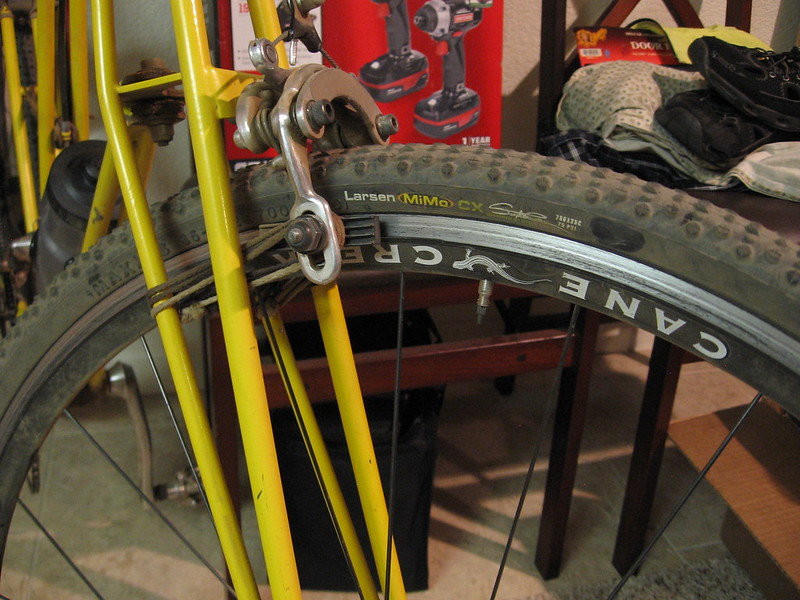
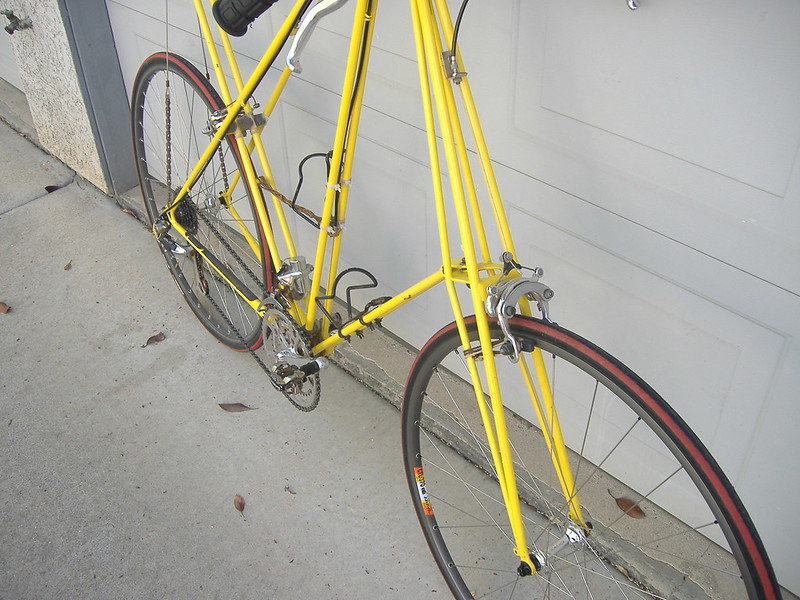
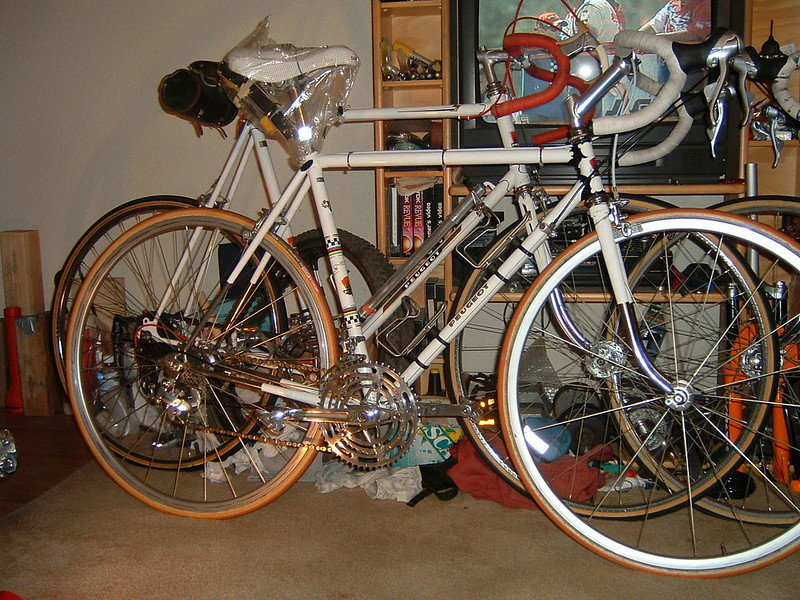
Last edited by dddd; 09-03-19 at 06:55 PM.
#17
Senior Member
I wouldn't count on having any poor result from using a shorter straddle wire. I used this approach myself, and aside from the difficulty of installing the straddle wire (had to disassemble the caliper), the result is right up there with the best rim braking that I have experienced.
Here's what happened when I tried a very short straddle wire. The brakes became very on or off feeling. It was stronger for sure, but I felt like the control was less, and I couldn't get more brake by just squeezing harder. They went straight to max, which was disconcerting. Maybe I just needed to play with it more. I considered a Spence Wolfe style booster plate as well. Maybe that makes for a good synergy. I may still try that some day. Just couldn't be bothered at the time. What I ended up doing was using a Tektro fancy straddle on the front brake, which if I'm not mistaken effectively shortens the straddle just slightly. The 610s on my Mercian tourer are still set up that way and I'm very satisfied.
Before that I was using a standard cable with one of those Dia Compe zorks* (or something) to fix the other end. Rivendell used to sell them. BMX guys use them. They are still in my junk bin somewhere. I may give it another try based on your recommendation, some time in the future.
The floss wrap is an interesting idea. Calipers really do want to bend forward under hard braking.
*Knarps! they are called knarps.
#18
Senior Member
Thread Starter
Join Date: Oct 2005
Location: Fresno, CA
Posts: 4,454
Mentioned: 6 Post(s)
Tagged: 0 Thread(s)
Quoted: 128 Post(s)
Likes: 0
Liked 12 Times
in
10 Posts
That's one of the reasons to have caliper pivots brazed onto the frame, as I'm doing. The pad is not far from the point where the brake attaches to the frame (unlike most caliper brakes that mount at the top of the brake assembly), so there's much less flex of the pads being pulled forward by the direction of rim rotation.
#19
framebuilder
Doug, I notice that your rando rack just has a standard horizontal steel piece that connects to the center hole of the fork crown. I always figured this would interfere with the centerpull brake arms. Was it tricky for you to get that piece not interfereing with the brake arms? The alternative is front racks that whose secondary mounting point is on the brake bosses.
I was also going to mention that the old Dia Compe brakes used a much narrower width between posts that fit old style fork crowns that only had clearance for 32mm tires. New center pull brakes are much wider. That can make the miter of their posts sit way outside the center of the fork blades and look stupid.
#20
Senior Member
Thread Starter
Join Date: Oct 2005
Location: Fresno, CA
Posts: 4,454
Mentioned: 6 Post(s)
Tagged: 0 Thread(s)
Quoted: 128 Post(s)
Likes: 0
Liked 12 Times
in
10 Posts
Yes it was very tricky to get the customer supplied Velo Orange front rack to fit my old frame. I spent way too much time getting the bends of the horizontal piece just right so the top of the rack was level and also missed the brake arms. That also required creating a hole at its end so a bolt where the brake hole would normally be hold it in place. To make matters much worse the steel was so hard no normal drill bit could drill it. I had to use a grinding stone. It would have been easier to have made a custom rack for it.
I was also going to mention that the old Dia Compe brakes used a much narrower width between posts that fit old style fork crowns that only had clearance for 32mm tires. New center pull brakes are much wider. That can make the miter of their posts sit way outside the center of the fork blades and look stupid.
I was also going to mention that the old Dia Compe brakes used a much narrower width between posts that fit old style fork crowns that only had clearance for 32mm tires. New center pull brakes are much wider. That can make the miter of their posts sit way outside the center of the fork blades and look stupid.
#21
framebuilder
Just to be clear the Velo Orange rack I used was an old model that had just a straight horizontal piece to modify however until it fit somehow someplace on the frame. Later models have the horizontal piece already bent and holed to fit the fork crown brake hole and adjustable in length. That would have made my job a lot easier. Your best idea was to talk to your frame builder to come up with a solution he felt best able to make you happy.
#22
Senior Member
Thread Starter
Join Date: Oct 2005
Location: Fresno, CA
Posts: 4,454
Mentioned: 6 Post(s)
Tagged: 0 Thread(s)
Quoted: 128 Post(s)
Likes: 0
Liked 12 Times
in
10 Posts
Just to be clear the Velo Orange rack I used was an old model that had just a straight horizontal piece to modify however until it fit somehow someplace on the frame. Later models have the horizontal piece already bent and holed to fit the fork crown brake hole and adjustable in length. That would have made my job a lot easier. Your best idea was to talk to your frame builder to come up with a solution he felt best able to make you happy.
#23
Senior Member
That's one of the reasons to have caliper pivots brazed onto the frame, as I'm doing. The pad is not far from the point where the brake attaches to the frame (unlike most caliper brakes that mount at the top of the brake assembly), so there's much less flex of the pads being pulled forward by the direction of rim rotation.
#24
Ride, Wrench, Swap, Race
Join Date: Jan 2010
Location: Northern California
Posts: 9,194
Bikes: Cheltenham-Pedersen racer, Boulder F/S Paris-Roubaix, Varsity racer, '52 Christophe, '62 Continental, '92 Merckx, '75 Limongi, '76 Presto, '72 Gitane SC, '71 Schwinn SS, etc.
Mentioned: 132 Post(s)
Tagged: 0 Thread(s)
Quoted: 1565 Post(s)
Liked 1,296 Times
in
866 Posts
Yes, the brazed studs will better preserve pad alignment with the rim.
Reducing the friction at the pivots is the other huge benefit of adding pad tethers, and which somewhat negates the benefits of brazed bosses by preserving pad alignment in a more direct way (where the force in the direction of rim motion doesn't even reach the arms!).
The tethers should be situated to the inside of the fork legs, which adds a bit of self-energization (power) to the braking force.
It is quite noticeable how the tethers actually make the lever feel more like it is attached more directly to the caliper, rather than with a cable, i.e. modulation/response is much improved.
The booster plates are easily fabricated at home, but do require that longer bolts be used. These further improve pad alignment with the rim in terms of greatly reducing fluctuation of the toe-in as the braking force changes.
Reducing the friction at the pivots is the other huge benefit of adding pad tethers, and which somewhat negates the benefits of brazed bosses by preserving pad alignment in a more direct way (where the force in the direction of rim motion doesn't even reach the arms!).
The tethers should be situated to the inside of the fork legs, which adds a bit of self-energization (power) to the braking force.
It is quite noticeable how the tethers actually make the lever feel more like it is attached more directly to the caliper, rather than with a cable, i.e. modulation/response is much improved.
The booster plates are easily fabricated at home, but do require that longer bolts be used. These further improve pad alignment with the rim in terms of greatly reducing fluctuation of the toe-in as the braking force changes.
Last edited by dddd; 09-04-19 at 11:42 PM.





